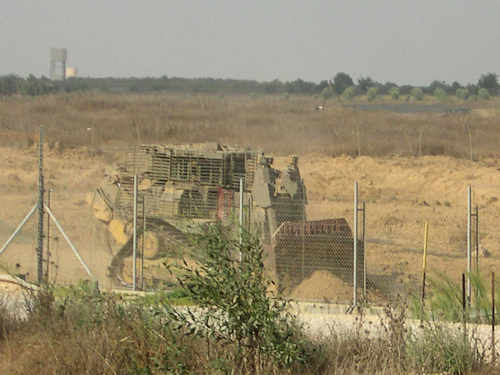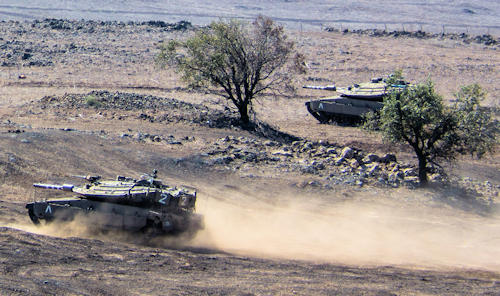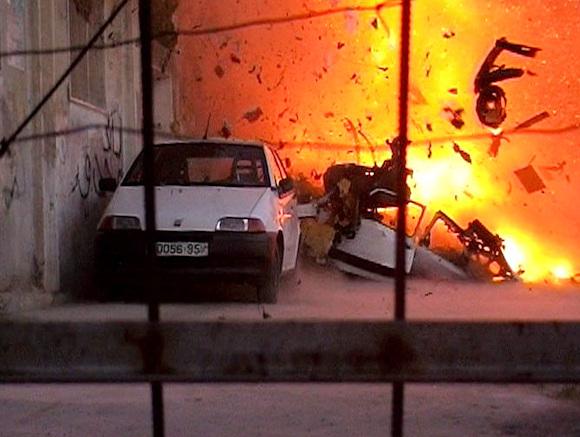Over the last few years, the various conflicts that have broken out in the world have hardly seen a balance between the belligerents. Equilibrium means the risk of defeat, so in general those who attack are convinced to achieve rapid success, by virtue of an alleged strategic superiority - better quality of the military, powerful allies, technological superiority.
In 'Art of War of Sun Tzu (5th century BC), it is asserted that those in inferiority try to find a strategy that, perhaps in the long run, wears out the enemy. In fact, the fundamental point is never to constitute a target, on which the greatest firepower of the adversary can concentrate. To survive divided and then to strike together, wearing men and means, but above all the psychological resistance of the adversary, especially in societies that are evolved and not inclined to sacrifice like those of the West.
A working example could be the Operation Rain of Summer conducted in Lebanon by the Israelis in the 2006. The IDF (Israel Defense Forces), recognized internationally as one of the Armed Forces with a very high level of efficiency, failed to obtain a decisive victory against the formations of the Hezbollah.
On paper, the clash had no history, both in terms of opposing forces and armaments. However, asymmetric conflicts present great dangers for the armies of the developed nations - protection of the lives of their soldiers, pressure of public opinion, relations with international organizations - as the Pentagon has been able to see over the years.
I warriors of god they worked out, with the help of Iranian instructors, tactics to counter the military potential of Tel Aviv.
 For starters no attempt to deploy a conventional army, as did, for example, the PLO of Arafat up to 1982. Few heavy vehicles (easily identifiable), such as tanks and conventional artillery (such as the X-NEMX X-Mills XMUMX mm mounted on trucks) but a formation of many small teams of 30 / 122 elements, groupable only in certain tactical contexts, with armament light but able to cause significant damage to the enemy: rocket launcher RPG-5 and RPG-6; SA-7 infrared guided aircraft anti-aircraft missiles Gimlet; light mortars from 60 mm; anti-tank and very plastic explosive mines.
For starters no attempt to deploy a conventional army, as did, for example, the PLO of Arafat up to 1982. Few heavy vehicles (easily identifiable), such as tanks and conventional artillery (such as the X-NEMX X-Mills XMUMX mm mounted on trucks) but a formation of many small teams of 30 / 122 elements, groupable only in certain tactical contexts, with armament light but able to cause significant damage to the enemy: rocket launcher RPG-5 and RPG-6; SA-7 infrared guided aircraft anti-aircraft missiles Gimlet; light mortars from 60 mm; anti-tank and very plastic explosive mines.
For a clash of this kind, highly motivated personnel are needed, even better if indoctrinated to religious fanaticism, even willing to commit suicide. The result is a fanatical militiaman, able to remain hidden in a hole underground for weeks, to then emerge and carry out his attack, scornful of his own safety, for which there is no preventive deterrent.
The fundamentalists - whose religious beliefs place martyrdom as the current rule of life - are obviously aware that a government of a democratic country expects its military to obtain results in the shortest possible time and with the least possible losses.
This assumption has already proved innumerable times its impossibility to be realized in many conflicts. It happened in the former Yugoslavia in the 1999 (at least for the zero losses) but it was a state structure, with precise targets to be neutralized. However when targets are missing paying to hit everything becomes much more difficult and dangerous.
Hezbollah had already put this strategy into practice, before the 2000, when it had occupied all of southern Lebanon, following the withdrawal of Israeli troops.
Just during the long Israeli occupation - arising from the need to protect themselves from the Palestinian attacks, always coming from these areas - Hezbollah has developed these fighting techniques, due to many losses among the IDF files, so as to induce the Government of Tel Aviv to unilateral withdrawal.

Superficially, the situation created after the 2000 seemed more stable. However, Tehran's influence in the region was increasing over time.
Iran has supplied arms to Hezbollah (but also substantial funds for the civil management of the territories under its control), taking care, through the sending of counselors, training and ideological indoctrination. In the end, the Jewish state found itself with 80 boundary km not with Lebanon but with Iran, plus the absence of industrial targets on which to leverage, with possible military actions.
The Israeli withdrawal from Lebanon - also driven by public opinion, very sensitive to losses - was aimed at stabilizing the area. At first the choice seemed to be successful, but soon it was realized that Hezbollah, with Iranian support, began to intensify attacks on Israeli territory.
Despite the information about the strengthening of Hezbollah, Israeli intelligence had not been able to fully understand the quantity of armaments arrived. However, the chances of infiltrating such a movement, precisely because of its fundamentalist nature, appear to be very difficult. It is also true that the Olmert government - center-left - had no intention of getting involved in a large-scale military operation; but he found himself faced with a continuous series of attacks on the Israeli population.
A further aggression and the capture of two Israeli soldiers, 12 July 2006, has led Tel Aviv to react, with an originally limited offensive and aimed only to neutralize the Hezbollah's war capacity. However, the latter have proved to be extremely elusive, as well as animated by great fanaticism.
 I Warriors of God they showed an amazing technological capacity, also using Chinese anti-ship cruise missiles C-802, but also large-caliber field rockets - probably 330 mm rockets of Soviet origin - able to hit Haifa (for size it is the third Israeli city, never previously bombed), as well as inhabited centers even further south.
I Warriors of God they showed an amazing technological capacity, also using Chinese anti-ship cruise missiles C-802, but also large-caliber field rockets - probably 330 mm rockets of Soviet origin - able to hit Haifa (for size it is the third Israeli city, never previously bombed), as well as inhabited centers even further south.
Moreover, the IDF's attempt to hit the enemy military apparatus through air raids proved to be a failure - and could not be otherwise - due to the lack of targets paying. Although Tel Aviv had taken major political risks, as all the targets attacked, as in southern Beirut, were specially placed in civil structures, with consequent collateral damage.
The aviation airstrikes with the Star of David went on for about a month, along with sporadic clashes near the border, with losses on both fronts.
The D-9 and D-12 armored bulldozers have opened new tracks to allow the transit of armored vehicles, however Hezbollah managed to undermine them with large plastic explosives, able to put out even the heavy Merkava Mk IV (65.000 kg), or armored vehicles for infantry IDF ACHZARIT, derived from the hull of the old MBT Centurion.
Only in mid-August Tel Aviv made the decision to push the offensive up to the Litani River, as already happened in the 1978, creating the conditions for the deployment of a UN-led international contingent, a solution deemed satisfactory by the Olmert government, to preserve Israeli territory from further attacks.

From the strictly tactical point of view, the operation Spring rain he has demonstrated the limit of air power as an absolute resolver of conflicts, especially asymmetric ones, as modern militia groups are dispersed among civilians, knowing full well the political consequences, even at the international level, that any attacks would provoke.
So they need to boots on ground, to dislodge the militia, who had built a long network of tunnels, in which weapons and ammunition were hidden. Although Israeli assets are the most protected in the world - including their particular troop carrier vehicles, taken from the dismantled MBT hulls -, they have suffered considerable damage from Hezbollah who have succeeded in making numerous traps: buried plastic charges, mines, teams equipped with an anti-tank rocket launcher (RPG-7D; RPG-29 but also the Russian AT-13 Saxhorn 2), trained to hit from behind after having been overcome by the first wave.
The most consistent targets were represented by multiple field rocket launchers, against which the Israeli self-propelled artillery was activated in very short time, thanks also to the support of mini-drone cameras always flying over the targets (among other things also the Hezbollah , thanks to the presence of Iranian advisers, they used UAVs, one of which was intercepted and shot down at sea while flying over the southern coast of Israel). However, launch times were very low and these weapon systems were very well hidden. It is hypothesized that over 2.000 rockets have been launched on Israeli territory - from 107 to 330 mm - causing 40 casualties among civilians. Many of them have been launched without a specific objective - they are always bombs to saturate the area - falling in the countryside, but the volume of fire delivered has caused much apprehension among the population, given the lack of counter measures to counter these types of attacks (systems like the OTO 76 / 62 SUPER RAPIDO cannon would be needed, with the DAVID / DART project, able to modify the trajectory and break down artillery shells and mortar bombs).

The IDF nevertheless wanted to avoid being involved in urban fights, such as in the capital of Hezbollah Bin Jubail. The latter was surrounded and subjected to massive bombings, both from land and from the sky, with the intention of destroying the tunnels that were there.
Very often, the large armored bulldozers have literally leveled the enemy positions to eliminate their defenders, barricaded in a maze of tunnels. At other times we tried to resort to explosives.
The most recent anti-tank systems have also created various problems for the massive tanks Merkava. In fact, a hollow charge unloads all its perforating capacity (of the order of 700 / 900 mm of perforated homogeneous steel) on a very small surface, while the armor is distributed over the whole vehicle. Moreover, the hilly terrain obliged to precise directions of advance, which could not be modified any more. However it is i Merkava they proved to be excellent cashiers, in fact the losses among the crews were very limited, but they are not indestructible.
The Hezbollah counter-truck systems have often proved insidious. For example, when the 12 in August, Israeli departments advanced into Wadi Saluki, near the villages of Farun and Andurya, south of the Litani river. The tanks of the 162ᵃ Armored Brigade were blocked by a strong deployment of laser-guided AT-13 anti-tank missiles.
The wagons advanced into the open field in a flat area and Hizbullah targeted them from the surrounding hills, despite the artillery fire and Israeli fighters, intervening quickly in their support. In addition, the wagons are finished on a minefield, consisting of mines aggregated to powerful explosive charges, capable of damaging even the heavy Merkava.
The commander's chariot training blew up on one of these devices. Eight soldiers died in the tanks hit in the battle; four of the fallen infantry and four other wounded died despite the rapidity of relief efforts.
 It is conceivable that a formation with other types of armor would have suffered higher losses but the most serious error was to continue the advance on uncovered terrain. Obviously the militia have suffered huge losses, but for them the losses have another meaning. The military analysts believe that the hypothesis that the offensive to the south of the Litani river was halted when Hezbollah was on its last legs, having suffered heavy losses in terms of fighters, is plausible. Many died in the collapses of the bulldozer-flattened tunnels or destroyed by the guided bombs of the planes, obviously the exact number of the fallen among Hezbollah will never be known. Also in this there is total asymmetry.
It is conceivable that a formation with other types of armor would have suffered higher losses but the most serious error was to continue the advance on uncovered terrain. Obviously the militia have suffered huge losses, but for them the losses have another meaning. The military analysts believe that the hypothesis that the offensive to the south of the Litani river was halted when Hezbollah was on its last legs, having suffered heavy losses in terms of fighters, is plausible. Many died in the collapses of the bulldozer-flattened tunnels or destroyed by the guided bombs of the planes, obviously the exact number of the fallen among Hezbollah will never be known. Also in this there is total asymmetry.
There were no casual incidents, such as the rocket that fell on an Israeli camp causing 12 casualties (practically 10% of all Israeli casualties in the conflict, equivalent to 127 military); a patrol ended up in a heavily trapped house, suffering heavy losses.
The impression is that by dint of wanting to avoid losses you risk not to get the desired results, also suffering damage, inevitable when you line up on the ground and you have before an extremely determined opponent, for whom any losses have a value minor.
It is interesting to note how the line of ceasefire between Israel and Syria, at least until 2011, was quiet. An explanation could be found in the fact that the Syrians are aware that the Israeli artillery (especially the bullets deflated by 175 mm of the M-107 self-propelled howitzers) can hit the capital Damascus from the slopes of Mount Hermon. Moreover, the Tel Aviv aviation could literally annihilate the industrial apparatus and infrastructure of Syria, with devastating consequences also for the military apparatus.
But what to strike with Hezbollah?
 Air power has its validity when there are concrete targets and paying to be hit, when it is necessary to hunt down small groups of militiamen it is of little use. In this case soldiers are needed on the ground, with all the consequences of the case.
Air power has its validity when there are concrete targets and paying to be hit, when it is necessary to hunt down small groups of militiamen it is of little use. In this case soldiers are needed on the ground, with all the consequences of the case.
In this regard, the Israeli army has a very flexible structure and regularly trained to operate in combat groups (Task Force), at all levels, up to the divisional one. So it is quite unusual for a brigade or battalion to land on the ground, preferring heterogeneous departments composed of armored, mechanized and artillery units, with various structures according to the threat to be faced.
Regarding special forces, these include permanent departments and the reserve. Those in the paratroopers are among the most trained and are used for in-depth raids. Units for strategic missions report directly to the Army General Staff and are included in the Sareyet Mat'gal.
Despite the undoubted operational capabilities of the IDF, defeating an irregular organization, equipped with sophisticated weapons, camouflaged among the civilian population, proved to be an impossible mission.
The collateral damage has been a source of intense discussion, even at international level. In southern Lebanon, many villages, where Shiite fundamentalists were not found, were not attacked, proving that Israeli military action was selective. In fact, Tel Aviv had ensured to warn civilians to abandon certain areas, where it was believed that targets were to be found, as the Hezbollah had many shelters and deposits of weapons hidden among the houses.
Despite these measures, the Holmert government, engaging in the operation Rain of Summer, has collected not only many criticisms from international organizations - for the serious damage suffered by Lebanese civil structures - but also the criticism of the military, in Israel equivalent to the entire population, as the policy adopted was too hesitant and lacking wide-ranging strategy.
(photo: IDF / web)












